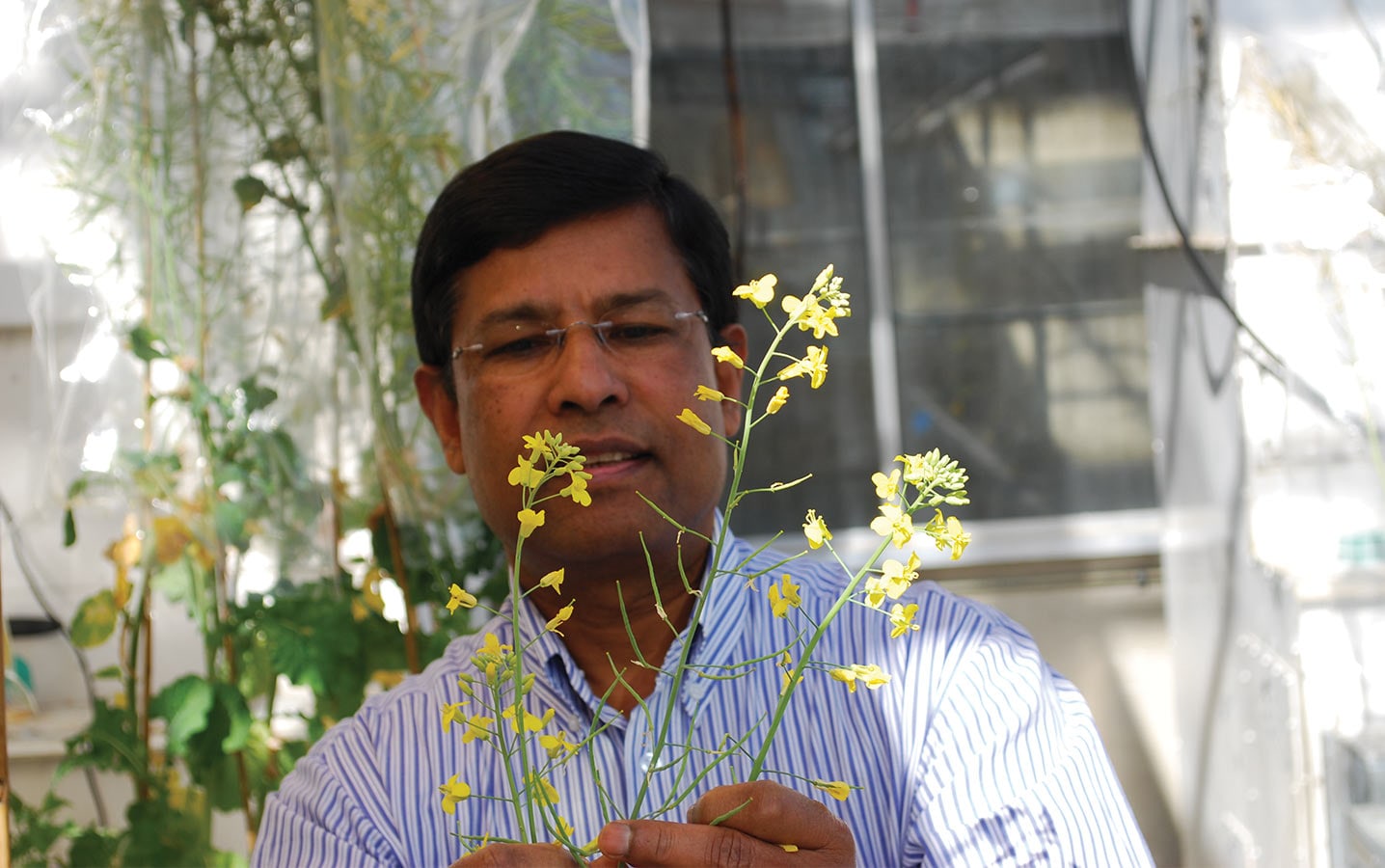Clubroot resistance saves canola in central Alberta
Clubroot resistance is a priority at the University of Alberta canola breeding program. Finding good clubroot-resistant (CR) genes is just the first step.
A collaboration between Rahman’s lab and Crop Production Services (a subsidiary of Agrium Inc.) is making new hybrids with improved genetic resistance to clubroot available to farmers. The latest commercial variety to come out of this collaboration is PV 580 GC.“Developing varieties with clubroot resistance is not about putting a single gene into a single plant,” says Habibur Rahman, professor and canola breeder at the university. “It is a challenging process of developing a package of traits that includes disease resistance, high yields, yield stability and good agronomic and seed quality traits.”
The first step was to screen and identify sources of disease resistance from related germplasm and other Brassica species. Rahman and his team used a CR gene from Mendel, which is a winter canola cultivar from Europe, and another gene from a distant rutabaga relative. Transfer of genes from an unadapted germplasm like rutabaga is a big challenge, Rahman says. When crossed to canola, it also brings along other undesired traits that must be removed at the same time as bringing in the desirable traits.
“From this breeding work, we developed several hybrid parent lines that included all of the desirable traits we were targeting, including clubroot resistance genes,” explains Rahman. “These hybrid parent lines were provided to CPS, who added them to their breeding program to release hybrid cultivars with double clubroot resistance for growers.”
Rahman’s clubroot breeding program, which continues, is funded by Alberta Canola, the Canola Council of Canada, Agriculture and Agri-Food Canada, Alberta Crop Industry Development Fund (ACIDF) and Natural Sciences and Engineering Research Council (NSERC).
For CPS, the collaboration with Rahman’s breeding work is an integral part of their commercial breeding program. “To stay on the leading edge of hybrid development, we cannot work on all of the traits ourselves, so using a divide-and-conquer approach allows us to make advancement much quicker,” says C.P. (Andy) Andrahennadi, senior hybrid breeder with CPS. “Another benefit of our collaborations is that these traits are tested, evaluated and bred in Western Canada. Clubroot resistance is a good example of this approach where the clubroot genetics were developed at the University of Alberta, screened and tested in central Alberta in the heart of the clubroot disease region and commercial hybrids developed in Western Canada.”
More hybrids to follow
Identifying a source of resistance involves screening hundreds of diverse Brassica lines against multiple pathotypes of the clubroot pathogen.
If the resistance comes from a wild or distantly-related species, then it takes more time to work these traits into adaptable genetics. In a normal program, it can take four or five years from trait identification to the commercialization stage.
This process includes taking the university’s clubroot-resistant “mother lines” and converting them to male-sterile lines for hybrid seed production. The hybrid step includes crossing these mother lines and CPS father parent lines, which are produced in South America in Chile over the winter.
“These hybrid lines come back to Canada every spring and are tested not only for yield, but also yield stability, vigour, maturity, lodging and dedicated screening trials for clubroot, blackleg and fusarium wilt resistance,” says Andrahennadi. “These hybrids not only mean growers in clubroot-infested areas can continue to grow this crop, they also greatly reduce the development of galls and spore production that typically occurs on susceptible varieties, which further reduces the risk of spreading the disease.”
The new hybrid PV 580 GC is resistant to multiple clubroot pathotypes, including the predominant pathotypes found in Alberta, as well as recently-identified pathotype 5x, which is virulent on CR canola varieties carrying only single-gene resistance. Andrahennadi says more CR hybrids from the program will soon follow.
Genetic resistance is one of the key tools that farmers can use in a multi-disciplined approach to disease management. “Over 30 per cent of the world’s food is lost to perils such as diseases, drought and other factors, making it difficult for producers to fully realize yield potential in a commercial farm setting,” explains Andrahennadi. “Therefore, hybrids with built-in levels of disease resistance to serious diseases like clubroot or blackleg are tremendously important for producers to be able to realize higher yield potential from their crops and maximize returns.”





